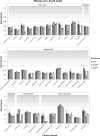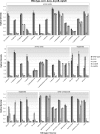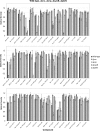Global regulation of food supply by Pseudomonas putida DOT-T1E
- PMID: 20139187
- PMCID: PMC2849455
- DOI: 10.1128/JB.01129-09
Global regulation of food supply by Pseudomonas putida DOT-T1E
Abstract
Pseudomonas putida DOT-T1E was used as a model to develop a "phenomics" platform to investigate the ability of P. putida to grow using different carbon, nitrogen, and sulfur sources and in the presence of stress molecules. Results for growth of wild-type DOT-T1E on 90 different carbon sources revealed the existence of a number of previously uncharted catabolic pathways for compounds such as salicylate, quinate, phenylethanol, gallate, and hexanoate, among others. Subsequent screening on the subset of compounds on which wild-type DOT-TIE could grow with four knockout strains in the global regulatory genes Deltacrc, Deltacrp, DeltacyoB, and DeltaptsN allowed analysis of the global response to nutrient supply and stress. The data revealed that most global regulator mutants could grow in a wide variety of substrates, indicating that metabolic fluxes are physiologically balanced. It was found that the Crc mutant did not differ much from the wild-type regarding the use of carbon sources. However, certain pathways are under the preferential control of one global regulator, i.e., metabolism of succinate and d-fructose is influenced by CyoB, and l-arginine is influenced by PtsN. Other pathways can be influenced by more than one global regulator; i.e., l-valine catabolism can be influenced by CyoB and Crp (cyclic AMP receptor protein) while phenylethylamine is affected by Crp, CyoB, and PtsN. These results emphasize the cross talk required in order to ensure proper growth and survival. With respect to N sources, DOT-T1E can use a wide variety of inorganic and organic nitrogen sources. As with the carbon sources, more than one global regulator affected growth with some nitrogen sources; for instance, growth with nucleotides, dipeptides, d-amino acids, and ethanolamine is influenced by Crp, CyoB, and PtsN. A surprising finding was that the Crp mutant was unable to flourish on ammonium. Results for assayed sulfur sources revealed that CyoB controls multiple points in methionine/cysteine catabolism while PtsN and Crc are needed for N-acetyl-l-cysteamine utilization. Growth of global regulator mutants was also influenced by stressors of different types (antibiotics, oxidative agents, and metals). Overall and in combination with results for growth in the presence of various stressors, these phenomics assays provide multifaceted insights into the complex decision-making process involved in nutrient supply, optimization, and survival.
Figures





References
-
- Arias, S., E. R. Olivera, M. Arcos, G. Naharro, and J. M. Luengo. 2008. Genetic analyses and molecular characterization of the pathways involved in the conversion of 2-phenylethylamine and 2-phenylethanol into phenylacetic acid in Pseudomonas putida U. Environ. Microbiol. 10:413-432. - PubMed
-
- Barkay, T., S. M. Miller, and A. O. Summers. 2003. Bacterial mercury resistance from atoms to ecosystems. FEMS Microbiol. Rev. 27:355-384. - PubMed
Publication types
MeSH terms
Substances
LinkOut - more resources
Full Text Sources
Other Literature Sources
Research Materials
Miscellaneous

